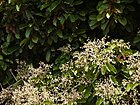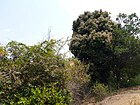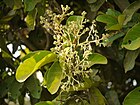Note: This is a project under development. The articles on this wiki are just being initiated and broadly incomplete. You can Help creating new pages.
Difference between revisions of "Vateria indica - Ajakarna, Piney"
| Line 4: | Line 4: | ||
==Uses== | ==Uses== | ||
| − | {{Uses| | + | {{Uses|Bloaitng}}, {{Uses|Abdominal pain}}, {{Uses|Gout}}, {{Uses|Neck stiffness}}, {{Uses|Skin eruptions}}, {{Uses|Locked jaw paralysis}}, {{Uses|Pimples}}, {{Uses|Diarrhea}}, {{Uses|Sore throats}} |
==Parts Used== | ==Parts Used== | ||
| Line 22: | Line 22: | ||
Tikta (Bitter), Kashaya (Astringent) | Tikta (Bitter), Kashaya (Astringent) | ||
===Guna=== | ===Guna=== | ||
| − | + | Snigda (unctuous) | |
===Veerya=== | ===Veerya=== | ||
| − | + | Sheeta (cold) | |
===Vipaka=== | ===Vipaka=== | ||
Katu (Pungent) | Katu (Pungent) | ||
| Line 36: | Line 36: | ||
==Identification== | ==Identification== | ||
===Leaf=== | ===Leaf=== | ||
| − | {{Leaf|Simple|| | + | {{Leaf|Simple|alternate|Leaves are spiral; stipules caducous; petiole 2-3.5 cm, swollen at apex, nearly glabrous}}<ref name="Leaf"/> |
===Flower=== | ===Flower=== | ||
| − | {{Flower|Unisexual|2-4cm long| | + | {{Flower|Unisexual|2-4cm long|white|5-20|Inflorescence axillary panicles with dense stellate hairs}} |
===Fruit=== | ===Fruit=== | ||
| − | {{Fruit|| | + | {{Fruit|Capsule| 6.4 x 3.8 cm|3-valved, calyx persistent, reflexed|With hooked hairs|-}} |
===Other features=== | ===Other features=== | ||
| Line 61: | Line 61: | ||
==Photo Gallery== | ==Photo Gallery== | ||
<gallery class="left" caption="" widths="140px" heights="140px"> | <gallery class="left" caption="" widths="140px" heights="140px"> | ||
| − | + | ||
| − | + | Bili Daamaru (Kannada- ಬಿಳಿ ಡಾವರು) (6792201786).jpg | |
| − | + | ||
| + | Bili Dhupa (Kannada- ಬಿಳಿ ಧೂಪ) (8592202955).jpg | ||
| + | |||
| + | |||
| + | Chandrusa (Marathi- चंद्रुस) (6792207852).jpg | ||
| + | Chandrusa (Marathi- चंद्रुस) (6792207852).jpg | ||
| + | |||
| + | Dhupada Mara (Kannada- ಧೂಪದ ಮರ) (8593306972).jpg | ||
| + | |||
| + | |||
| + | Indian Copal (Vateria indica L.); branch with flowers, leave Wellcome V0042605.jpg | ||
| + | |||
| + | |||
| + | Paini (Malayalam- പയിനി) (6938311577).jpg | ||
| + | |||
</gallery> | </gallery> | ||
| Line 71: | Line 85: | ||
<ref name="chemical composition">[https://herbs.indianmedicinalplants.info/index.php/sanskrit-names-of-plants/36-2012-02-18-18-09-08/93-vateria-indica "chemical constituents"]</ref> | <ref name="chemical composition">[https://herbs.indianmedicinalplants.info/index.php/sanskrit-names-of-plants/36-2012-02-18-18-09-08/93-vateria-indica "chemical constituents"]</ref> | ||
| − | <ref name="Leaf">[https:// | + | <ref name="Leaf">[https://indiabiodiversity.org/species/show/19732 "Diagnostic description"]</ref> |
<ref name="How to plant/cultivate">[https://www.pfaf.org/user/Plant.aspx?LatinName=Vateria+indica "Cultivation details"]</ref> | <ref name="How to plant/cultivate">[https://www.pfaf.org/user/Plant.aspx?LatinName=Vateria+indica "Cultivation details"]</ref> | ||
| Line 78: | Line 92: | ||
==External Links== | ==External Links== | ||
* [https://www.ncbi.nlm.nih.gov/pubmed/20930407 Chemical constituents in the leaves of Vateria indica] | * [https://www.ncbi.nlm.nih.gov/pubmed/20930407 Chemical constituents in the leaves of Vateria indica] | ||
| − | * [ | + | * [http://tropical.theferns.info/viewtropical.php?id=Vateria+indica Vateria indica on useful trophical plants] |
| − | * [https:// | + | * [https://sites.google.com/site/efloraofindia/species/a---l/d/dipterocarpaceae/vateria/vateria-indica Vateria indica on sites.google.com] |
| − | + | * [https://easyayurveda.com/2015/04/24/sarja-vateria-indica-uses-dose-research-side-effects/ Vateria indica on easyayurveda.com] | |
| − | * [https:// | + | |
[[Category:Herbs]] | [[Category:Herbs]] | ||
Revision as of 14:34, 13 June 2018
Vateria indica is a species of plant in the Dipterocarpaceae family. It is endemic to India. It is threatened by habitat loss. This tree grows like a palm but has blunt thorns along its trunk.
Contents
- 1 Uses
- 2 Parts Used
- 3 Chemical Composition
- 4 Common names
- 5 Properties
- 6 Habit
- 7 Identification
- 8 List of Ayurvedic medicine in which the herb is used
- 9 Where to get the saplings
- 10 Mode of Propagation
- 11 How to plant/cultivate
- 12 Commonly seen growing in areas
- 13 Photo Gallery
- 14 References
- 15 External Links
Uses
Bloaitng, Abdominal pain, Gout, Neck stiffness, Skin eruptions, Locked jaw paralysis, Pimples, Diarrhea, Sore throats
Parts Used
Chemical Composition
Bark contains Dl-epicatechin, fischinidol and afzetechin. Tree yields a resin which is a complex mixture of triterpenes. Seeds yield semi solid fat known as Piney tallow or Malabar tallow. Fruit shell yields tannins. Gum yields lipids.[1]
Common names
| Language | Common name |
|---|---|
| Kannada | Damar |
| Hindi | Badasal |
| Malayalam | Baine, Kunturukkam |
| Tamil | Dhupa maram |
| Telugu | |
| Marathi | NA |
| Gujarathi | NA |
| Punjabi | NA |
| Kashmiri | NA |
| Sanskrit | |
| English | White Damar, Indian Copal |
Properties
Reference: Dravya - Substance, Rasa - Taste, Guna - Qualities, Veerya - Potency, Vipaka - Post-digesion effect, Karma - Pharmacological activity, Prabhava - Therepeutics.
Dravya
Rasa
Tikta (Bitter), Kashaya (Astringent)
Guna
Snigda (unctuous)
Veerya
Sheeta (cold)
Vipaka
Katu (Pungent)
Karma
Kapha, Vata
Prabhava
Habit
Identification
Leaf
| Kind | Shape | Feature |
|---|---|---|
| Simple | alternate | Leaves are spiral; stipules caducous; petiole 2-3.5 cm, swollen at apex, nearly glabrous |
Flower
| Type | Size | Color and composition | Stamen | More information |
|---|---|---|---|---|
| Unisexual | 2-4cm long | white | 5-20 | Inflorescence axillary panicles with dense stellate hairs |
Fruit
| Type | Size | Mass | Appearance | Seeds | More information |
|---|---|---|---|---|---|
| Capsule | 6.4 x 3.8 cm | 3-valved, calyx persistent, reflexed | With hooked hairs | - | {{{6}}} |
Other features
List of Ayurvedic medicine in which the herb is used
- Vishatinduka Taila as root juice extract
Where to get the saplings
Mode of Propagation
How to plant/cultivate
A tree of low to moderate elevations in the moist, monsoonal tropics, where it can be found at elevations up to 1,200 metres[3]
Commonly seen growing in areas
west coastal evergreen forests of India, secondary evergreen dipterocarp forest.
Photo Gallery
References
External Links
- Ayurvedic Herbs known to be helpful to treat Bloaitng
- Ayurvedic Herbs known to be helpful to treat Abdominal pain
- Ayurvedic Herbs known to be helpful to treat Gout
- Ayurvedic Herbs known to be helpful to treat Neck stiffness
- Ayurvedic Herbs known to be helpful to treat Skin eruptions
- Ayurvedic Herbs known to be helpful to treat Locked jaw paralysis
- Ayurvedic Herbs known to be helpful to treat Pimples
- Ayurvedic Herbs known to be helpful to treat Diarrhea
- Ayurvedic Herbs known to be helpful to treat Sore throats
- Herbs with Seeds used in medicine
- Herbs with Bark used in medicine
- Herbs with common name in Kannada
- Herbs with common name in Hindi
- Herbs with common name in Malayalam
- Herbs with common name in Tamil
- Herbs with common name in English
- Habit - Herb
- Index of Plants which can be propagated by Seeds
- Index of Plants which can be propagated by Cuttings
- Herbs that are commonly seen in the region of west coastal evergreen forests of India
- Herbs that are commonly seen in the region of secondary evergreen dipterocarp forest
- Herbs






